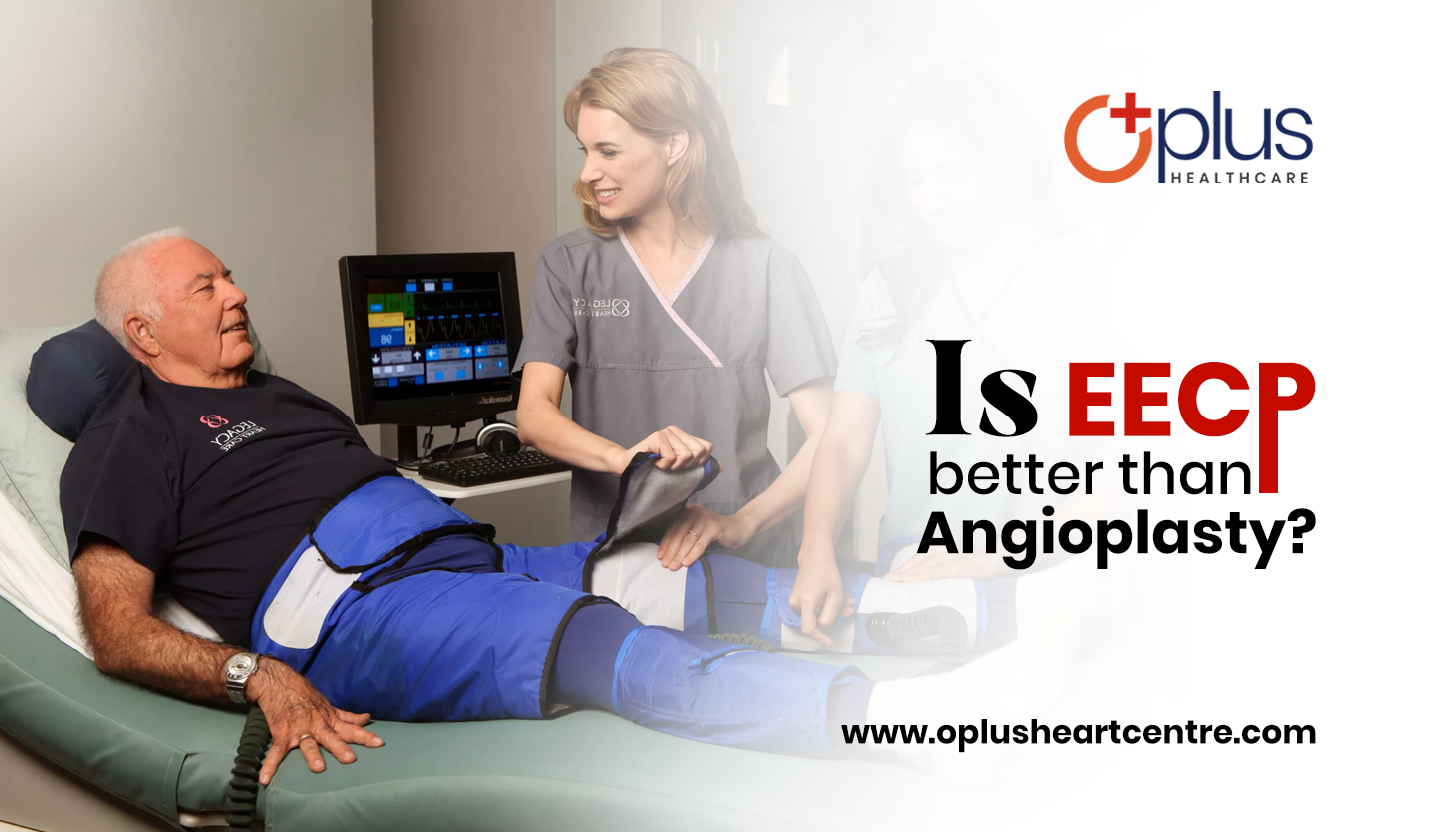- 12 December 2022
Is EECP better than Angioplasty: EECP (Enhanced External Counterpulsation) and Angioplasty are both minimally invasive treatments in use to improve blood flow in people with chronic coronary artery disease. While each has its own benefits, the ultimate decision of which to pursue depends on a patient’s individual health needs and preferences.
EECP is a noninvasive treatment involving the inflation and deflation of three specially designed cuffs around the legs that increase the pressure of the arteries of the legs, causing the heart to receive a greater volume of blood with each beat. It also entails medications and lifestyle changes that help to reduce or eliminate chest pain or discomfort.
In comparison, Angioplasty is a surgical procedure that uses a tiny balloon to flatten the plaque buildup inside the arteries. It works by pushing the artery walls outward, thus increasing the amount of space for the blood to flow through. It can often be performed on an outpatient basis and carries less risk of complications than more extensive surgeries.
When considering which of these treatments to pursue, it is important to review all available options. EECP may be better for some patients. As it is noninvasive and may reduce inflammation and symptoms associated with plaque buildup. Angioplasty is usually more effective at treating more serious and advanced cases of coronary artery disease and may be a better option for individuals who are unable to control their symptoms with lifestyle modifications.
Well, to help you in getting more clarity, here we will discuss the Is EECP better than Angioplasty. Let’s have a look!
Also, Read:
What is EECP treatment, how it helps in heart disease treatment?
Benefits of EECP over Angioplasty:
1. Non-Invasive Nature:
One of the greatest advantages of EECP over angioplasty is its non-invasive nature. Unlike angioplasty, which involves inserting a tube or wire into the coronary arteries, EECP does not involve any special preparation or recovery times. Rather, it is performed by simply placing a series of inflatable cuffs around the legs. This non-invasive approach reduces the risks associated with traditional angioplasty treatments and makes them more appealing to many patients.
2. Faster Recovery Time:
The second benefit of EECP is faster recovery times. Because the procedure relies on the constriction of the legs and feet, the actual procedure can be completed much faster than an angioplasty. In addition, the recovery time is significantly shorter with EECP, often only lasting a few hours.
3. Fewer Complications:
In addition to the faster recovery time, EECP also comes with fewer complications than angioplasty. As previously mentioned, angioplasty involves the insertion of a device in the coronary arteries, which could cause blood clots or damage to veins and arteries. With EECP, this is not a concern due to the non-invasive nature of the procedure.
4. Higher Success Rate:
While the overall success rate for EECP is lower than that of angioplasty, it still offers potential benefits to many patients. It is especially helpful for those with more severe cases of coronary artery disease, as the non-invasive nature of the procedure allows for more complete treatment of the affected areas.
5. Easier to Implement:
Another major benefit of EECP over angioplasty is the fact that it is much easier to implement. Because the procedure requires little preparation and recovery times, it can be easily implemented in specialized clinics and even in the comfort of the patient’s home. This makes it an ideal option for those who need quick treatment but cannot go to the hospital.
Note:
EECP offers several advantages over angioplasty, including its non-invasive nature, faster recovery time, fewer complications, lower success rate and easier implementation. While the success rates of EECP may be lower than those of the more traditional angioplasty, this procedure still offers an invaluable treatment option for those suffering from coronary artery disease.
Reach Oplus heart care center for EECP!
If you’re looking for innovative and effective treatments to help manage your heart health, then a visit to Oplus Heart Center may be a great choice. Opus offers a unique kind of therapy called enhanced external counterpulsation (EECP Treatment in India), which works to improve circulation. Unlike more invasive treatments like stents or bypass surgery, EECP offers patients a less invasive, non-surgical approach to treating their cardiovascular system.
This involves a machine that wraps around the patient’s chest and arms and applies gentle compressions to the arteries and veins of the lower half of the body. The timed contractions help reduce symptoms often associated with coronary artery disease and congestive heart failure, and can even reduce the risk of heart attack and stroke.
Also, Read:
Can EECP Replace Bypass Surgery?
FAQ: Is EECP better than Angioplasty
1. Can EECP reduce blood pressure?
Yes, EECP is a non-invasive therapy helps to reduce blood pressure. It works by increasing circulation in the body which helps to reduce the workload of the heart, which in turn can lower blood pressure.
2. What are the benefits of EECP?
The primary benefit of EECP is improvement in blood flow to the heart which can reduce the risk of cardiovascular disease and improve overall heart health. Additionally, EECP may reduce chest pain due to angina and improve physical activity tolerance. Other potential benefits of EECP include improved quality of life, improved cholesterol levels, and reduced symptoms of heart failure.
3. What is the success rate of EECP treatment?
The success rate of EECP treatment varies widely and is dependent on the individual patient. Clinical studies have reported good results in some cases, with an average improvement of 70% in circulation and other symptoms. Further research is important to establish the long-term effectiveness of EECP.
4. When is angioplasty not in consideration?
Angioplasty is not in consideration in cases where a patient has unstable angina, when certain clot-breaker medicines have already been administered, or when coronary arteries are too narrow to accept a stent.
5. Can EECP replace bypass?
No, EECP (or Enhanced External Counterpulsation) is a non-invasive therapy in use to treat coronary artery disease. However, bypass surgery is an invasive procedure to redirect blood flow around a blocked artery.



